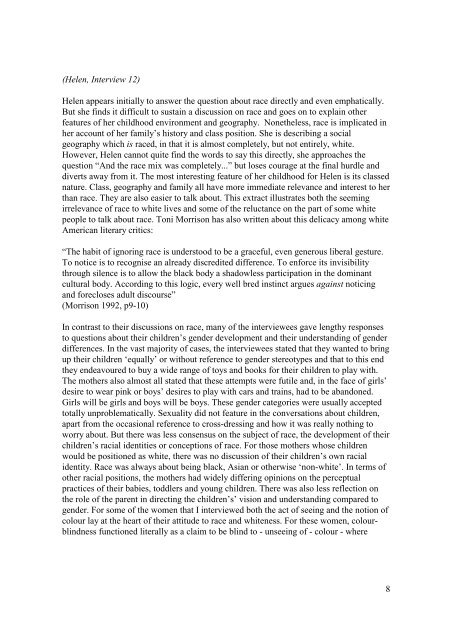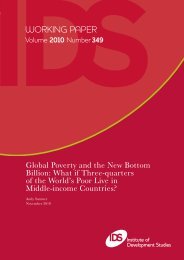1 'Troubling race. Using Judith Butler's work to think about racialised ...
1 'Troubling race. Using Judith Butler's work to think about racialised ...
1 'Troubling race. Using Judith Butler's work to think about racialised ...
Create successful ePaper yourself
Turn your PDF publications into a flip-book with our unique Google optimized e-Paper software.
(Helen, Interview 12)<br />
Helen appears initially <strong>to</strong> answer the question <strong>about</strong> <strong>race</strong> directly and even emphatically.<br />
But she finds it difficult <strong>to</strong> sustain a discussion on <strong>race</strong> and goes on <strong>to</strong> explain other<br />
features of her childhood environment and geography. Nonetheless, <strong>race</strong> is implicated in<br />
her account of her family’s his<strong>to</strong>ry and class position. She is describing a social<br />
geography which is <strong>race</strong>d, in that it is almost completely, but not entirely, white.<br />
However, Helen cannot quite find the words <strong>to</strong> say this directly, she approaches the<br />
question “And the <strong>race</strong> mix was completely...” but loses courage at the final hurdle and<br />
diverts away from it. The most interesting feature of her childhood for Helen is its classed<br />
nature. Class, geography and family all have more immediate relevance and interest <strong>to</strong> her<br />
than <strong>race</strong>. They are also easier <strong>to</strong> talk <strong>about</strong>. This extract illustrates both the seeming<br />
irrelevance of <strong>race</strong> <strong>to</strong> white lives and some of the reluctance on the part of some white<br />
people <strong>to</strong> talk <strong>about</strong> <strong>race</strong>. Toni Morrison has also written <strong>about</strong> this delicacy among white<br />
American literary critics:<br />
“The habit of ignoring <strong>race</strong> is unders<strong>to</strong>od <strong>to</strong> be a g<strong>race</strong>ful, even generous liberal gesture.<br />
To notice is <strong>to</strong> recognise an already discredited difference. To enforce its invisibility<br />
through silence is <strong>to</strong> allow the black body a shadowless participation in the dominant<br />
cultural body. According <strong>to</strong> this logic, every well bred instinct argues against noticing<br />
and forecloses adult discourse”<br />
(Morrison 1992, p9-10)<br />
In contrast <strong>to</strong> their discussions on <strong>race</strong>, many of the interviewees gave lengthy responses<br />
<strong>to</strong> questions <strong>about</strong> their children’s gender development and their understanding of gender<br />
differences. In the vast majority of cases, the interviewees stated that they wanted <strong>to</strong> bring<br />
up their children ‘equally’ or without reference <strong>to</strong> gender stereotypes and that <strong>to</strong> this end<br />
they endeavoured <strong>to</strong> buy a wide range of <strong>to</strong>ys and books for their children <strong>to</strong> play with.<br />
The mothers also almost all stated that these attempts were futile and, in the face of girls’<br />
desire <strong>to</strong> wear pink or boys’ desires <strong>to</strong> play with cars and trains, had <strong>to</strong> be abandoned.<br />
Girls will be girls and boys will be boys. These gender categories were usually accepted<br />
<strong>to</strong>tally unproblematically. Sexuality did not feature in the conversations <strong>about</strong> children,<br />
apart from the occasional reference <strong>to</strong> cross-dressing and how it was really nothing <strong>to</strong><br />
worry <strong>about</strong>. But there was less consensus on the subject of <strong>race</strong>, the development of their<br />
children’s racial identities or conceptions of <strong>race</strong>. For those mothers whose children<br />
would be positioned as white, there was no discussion of their children’s own racial<br />
identity. Race was always <strong>about</strong> being black, Asian or otherwise ‘non-white’. In terms of<br />
other racial positions, the mothers had widely differing opinions on the perceptual<br />
practices of their babies, <strong>to</strong>ddlers and young children. There was also less reflection on<br />
the role of the parent in directing the children’s’ vision and understanding compared <strong>to</strong><br />
gender. For some of the women that I interviewed both the act of seeing and the notion of<br />
colour lay at the heart of their attitude <strong>to</strong> <strong>race</strong> and whiteness. For these women, colourblindness<br />
functioned literally as a claim <strong>to</strong> be blind <strong>to</strong> - unseeing of - colour - where<br />
8

















